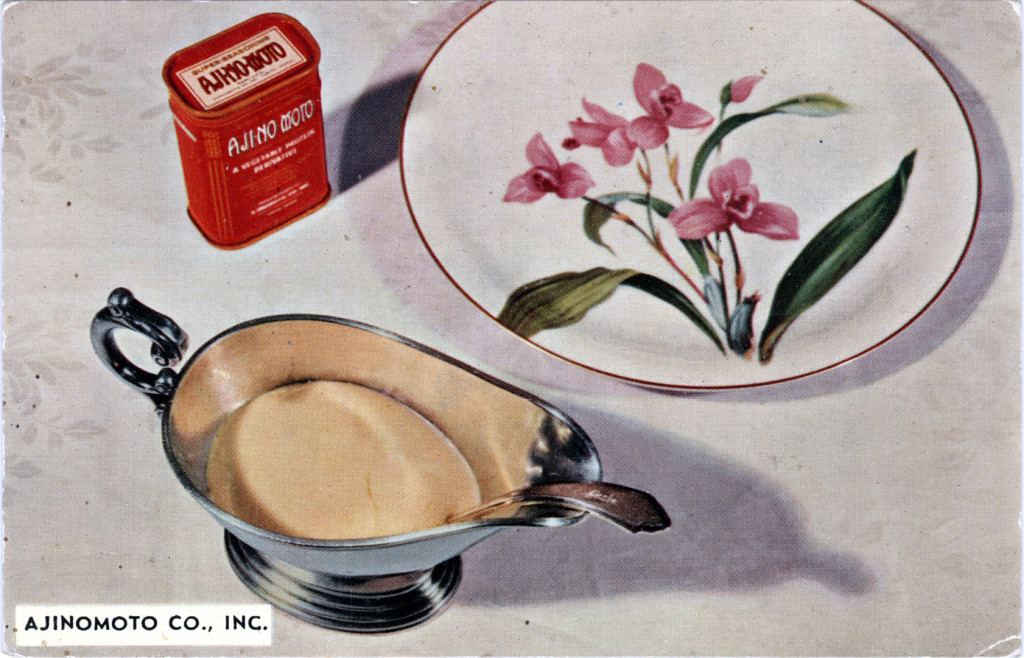
An advertising postcard, c. 1950, for Ajinomoto Co. Inc., with a tin of the product displayed at upper-left. Chemist Ikeda Kikunae first isolated glutamate from a broth of dried kelp (konbu dashi) in 1907, which he identified as a ‘pleasant savory taste’ and coined the word umami to describe it. In 1908, Ikeda received the patent for monosodium glutamate (MSG). The additive was given the trade-name ‘Ajinomoto’ (味の素, ‘essence of taste’), and was first marketed in Japan in 1909.
“The first stage of the story begins in 1908 with chemist Ikeda Kikunae’s isolation of the ingredient in sea kelp that gave flavor to konbu dashi, the standard Japanese broth. Trained in Germany, the center of organic chemistry at the time, Ikeda shared with his German colleagues a desire to develop a cheap and mass-manufactured source of nutrition.
“… The product that emerged from Ikeda’s laboratory, monosodium glutamate, was quickly patented in Japan, the United States, England, and France. In domestic announcements of his invention, Ikeda proposed calling its distinctive taste umami – a term derived from the colloquial masculine word in Japanese meaning ‘tasty’.
“Ikeda brought the powdered substance to iodine manufacturer Suzuki Saburo, whose Suzuki Chemical Company began marketing it in 1909 under the brand name Aji-no-moto, meaning ‘essence of taste’.
“… At fifty sen for the ‘home size’ bottle in 1912 (when fifty sen would have bought close to ten pounds of flour), it was not cheap. Women in whom frugality had been inculcated as the highest virtue had to be convinced that the unfamiliar powder was a necessary addition to their kitchens. Ajinomoto targeted them with several devices to achieve this goal.
“The company logo depicted a woman sporting a white apron and a Western-influenced sokuhatsu hairstyle, both marks of the modern bourgeois housewife. To appeal aesthetically to bourgeois women, the product was sold in slender glass bottles that looked like they might hold perfume. Most important, Ajinomoto marketers appealed to the Japanese housewife’s newfound sense of herself as a culinary professional and of her kitchen as a laboratory.”
– A Short History of MSG: Good Science, Bad Science, and Taste Cultures, by Jordan Sands, Gastronomica, Fall 2005
“The success of Musa-Shiya’s advertising led M. Kawahara, a wholesale distributor of Honolulu, to adopt a somewhat similar style in a newspaper campaign for introducing Aji-No-Moto, a new Japanese condiment.
“Aji-No-Moto is a powder, made from pure wheat from which much of the starch has been removed and to which certain salts have been added. The makers of Aji-No-Moto claim that these salts are noted for their value as flavoring elements and for certain medicinal properties that help to purify the blood and aid digestion.
“Aji-No-Mbto is recommended as a flavoring extract in the preparation of soups, gravies and other foods — it is even said to improve
the flavor of coffee — and while it is known and used by French chefs and Japanese, Chinese and Hawaiian cooks, it is not as yet widely used by Caucasians in Honolulu.“M. Kawahara proposed to popularize Aji-No-Moto [in Honolulu] by a newspaper campaign that would appeal first of all to women, then to children, and finally to the child in every adult.
“… One advertisement bears a heading, ‘To a stew (edible kind)’ and contains the following jingle:
Fizzle, fizzle, little stew,
What the deuce is wrong with you?
What is wrong? It’s plain to see
That you’re not what you ought to be.
Yet, if you are flavored right
You can be a real delight. •
Just a dash of Aji-No-Moto
Gives the flavor.
– “Sprightly Copy Makes Newspaper Campaign on Aji-No-Moto a Success”, by George Mellen, Printers’ Ink, June 21, 1923



